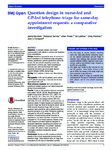Question design in nurse-led and GP-led telephone triage for same-day appointment requests: a comparative investigation
| dc.contributor.author | Pooler, J | en |
| dc.contributor.author | Murdoch, J | en |
| dc.contributor.author | Barnes, R | en |
| dc.contributor.author | Lattimer, VA | en |
| dc.contributor.author | Fletcher, E | en |
| dc.contributor.author | Campbell, JL | en |
| dc.date.accessioned | 2017-05-25T11:02:48Z | |
| dc.date.available | 2017-05-25T11:02:48Z | |
| dc.date.issued | 2014-03-05 | en |
| dc.identifier.uri | http://hdl.handle.net/10026.1/9348 | |
| dc.description.abstract |
Objective: To compare doctors’ and nurses’ communication with patients in primary care telephone triage consultations. Design: Qualitative comparative study of content and form of questions in 51 telephone triage encounters between practitioners (general practitioners (GPs)=29; nurses=22) and patients requesting a same-day appointment in primary care. Audio-recordings of nurse-led calls were synchronised with video recordings of nurse's use of computer decision support software (CDSS) during triage. Setting: 2 GP practices in Devon and Warwickshire, UK. Participants: 4 GPs and 29 patients; and 4 nurses and 22 patients requesting a same-day face-to-face appointment with a GP. Main outcome measure Form and content of practitioner-initiated questions and patient responses during clinical assessment. Results: A total of 484 question–response sequences were coded (160 GP; 324 N). Despite average call lengths being similar (GP=4 min, 37 s, (SD=1 min, 26 s); N=4 min, 39 s, (SD=2 min, 22 s)), GPs and nurses differed in the average number (GP=5.51, (SD=4.66); N=14.72, (SD=6.42)), content and form of questions asked. A higher frequency of questioning in nurse-led triage was found to be due to nurses’ use of CDSS to guide telephone triage. 89% of nurse questions were oriented to asking patients about their reported symptoms or to wider-information gathering, compared to 54% of GP questions. 43% of GP questions involved eliciting patient concerns or expectations, and obtaining details of medical history, compared to 11% of nurse questions. Nurses using CDSS frequently delivered questions designed as declarative statements requesting confirmation and which typically preferred a ‘no problem’ response. In contrast, GPs asked a higher proportion of interrogative questions designed to request information. Conclusions: Nurses and GPs emphasise different aspects of the clinical assessment process during telephone triage. These different styles of triage have implications for the type of information available following nurse-led or doctor-led triage, and for how patients experience triage. | en |
| dc.language.iso | en | en |
| dc.publisher | BMJ | en |
| dc.subject | Telephone triage | en |
| dc.subject | Primary Care | en |
| dc.subject | Question design | en |
| dc.title | Question design in nurse-led and GP-led telephone triage for same-day appointment requests: a comparative investigation | en |
| dc.type | Journal Article | |
| plymouth.author-url | http://jamie.murdoch@uea.ac.uk/ | en |
| plymouth.issue | 3 | en |
| plymouth.volume | 4 | en |
| plymouth.publisher-url | http://bmjopen.bmj.com/content/4/3/e004515.full | en |
| plymouth.journal | BMJ Open | en |
| dc.identifier.doi | 10.1136/bmjopen-2013-004515 | en |
| plymouth.organisational-group | /Plymouth | |
| plymouth.organisational-group | /Plymouth/REF 2021 Researchers by UoA | |
| plymouth.organisational-group | /Plymouth/REF 2021 Researchers by UoA/UoA03 Allied Health Professions, Dentistry, Nursing and Pharmacy | |
| plymouth.organisational-group | /Plymouth/Research Groups | |
| plymouth.organisational-group | /Plymouth/Research Groups/Institute of Health and Community | |
| dc.rights.embargoperiod | No embargo | en |
| rioxxterms.versionofrecord | 10.1136/bmjopen-2013-004515 | en |
| rioxxterms.licenseref.uri | http://www.rioxx.net/licenses/all-rights-reserved | en |
| rioxxterms.type | Journal Article/Review | en |


